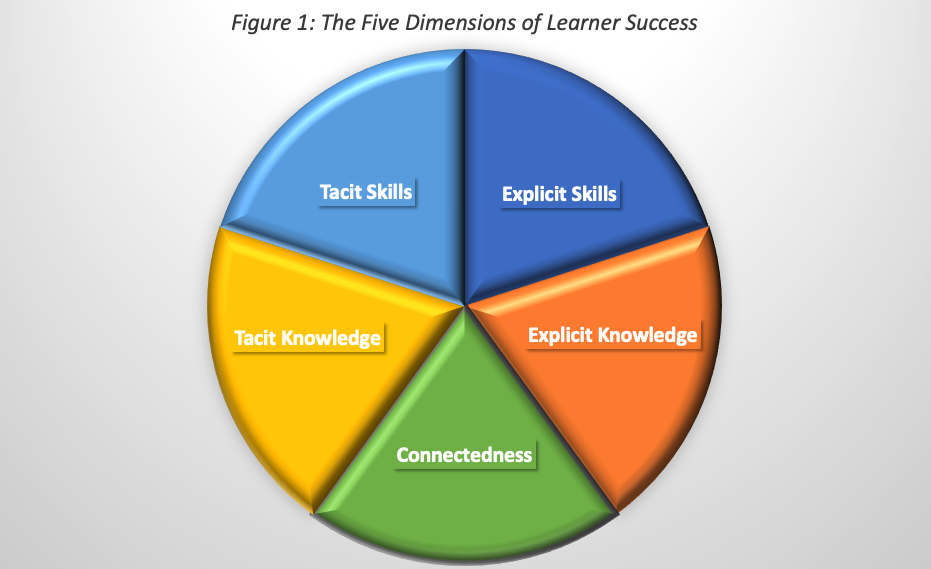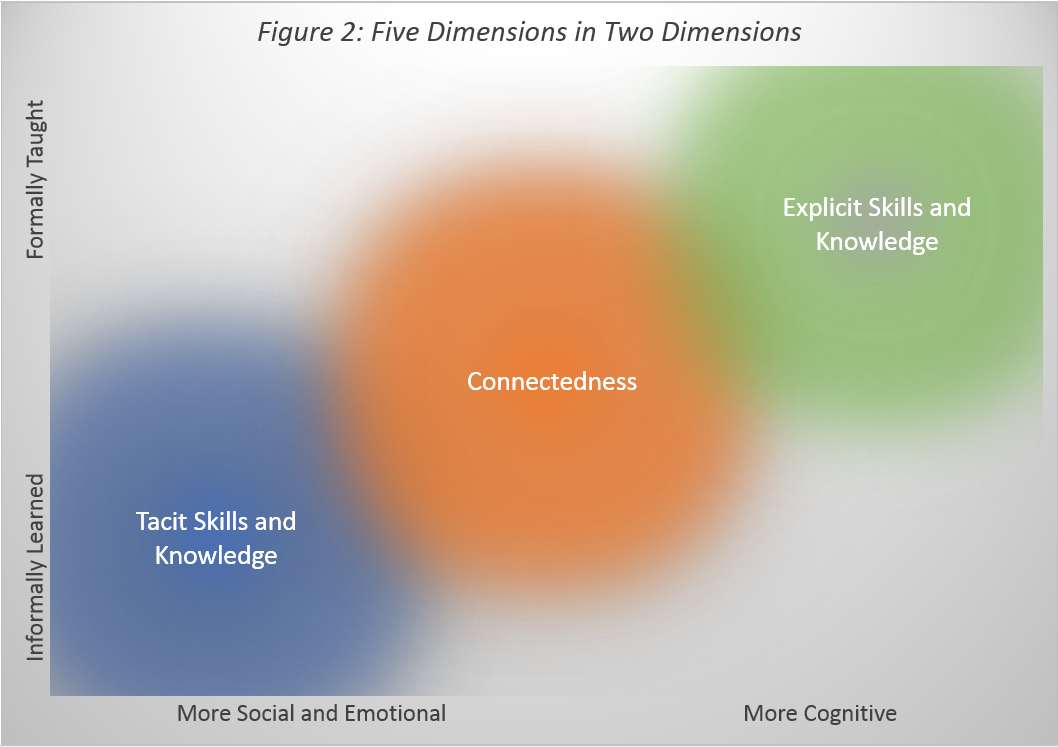5DL Tools: The Five Dimensions of High-Impact Learning
When we were looking for a name for the firm, we wanted something that spoke to the heart of what we are about: high-impact, success-changing, life-changing human development. In the end, we went back to the beginning, to one of the first questions our founders ever asked about human development.
And we called the firm fiveDlearning….
Simple questions can be powerful. More than 40 years ago, one of our founders asked a distinguished education leader “what are the universal learning competencies that, if any school anywhere on earth delivers them effectively to its students, that school’s stakeholders will say ‘you’ve done everything that you can reasonably do to prepare those students to succeed in school and in life’?” The leader didn’t have a good answer. No one else did, either. Thirty years and more than 18,000 research studies of educational improvement efforts later, we are beginning to have an adequate answer to that question. The answer is not simple, but it turns out to be extraordinarily powerful. It involves five key dimensions of learner success.
Let’s show the five dimensions first, define them, and then discuss where they come from, what they mean, how they inter-relate, and their implications for learner success. Here are the five, in Figure 1, below:

Explicit Skills are skills learned formally in school. Basic, general examples include reading, writing, and arithmetic, as well as penmanship, how to write a homework assignment, and so on. More specialized examples include computer programming, welding, cooking, and thousands of others.
Explicit Knowledge is
Tacit Knowledge is general and field-specific knowledge held by every successful person in a field that was not learned formally. Examples may include knowing what are the best-paying professions or those with the best work-life balance, which are the top firms in a particular field, and so on.
Tacit Skills are, like tacit knowledge, held by every successful person in a field but not taught formally. Examples may include knowing how to write an effective memo, to interview or ask for a raise successfully, career management skills, and even critical thinking skills (more about this below).
Connectedness is a measure of how well-engaged a person is with the people in his or her personal and professional environment. In every culture worldwide, well-connected people succeed further and faster, fall less often, and when they do fall, recover faster and more fully than those who are less well-connected personally and professionally. Another way to understand connectedness is that it is the set of knowledge and skills required to build, sustain, and use trust relationships with others.
Where do the 5Ds come from? Over the past 30 years, our founders and diverse colleagues and collaborators have performed and meta-analyzed studies of educational improvement culled from around the globe (in all, more than 18,000 studies from more than 60 nations, representing every populated continent). We were looking for universal success-factors: the things that made a positive difference for learners in every kind of diverse educational environment. We concluded early that there is no single, simple set of knowledge and skills that
Four of the categories were easy to identify. Educators focus almost all their work on teaching formal skills and knowledge: we renamed these categories ‘explicit’ because they can be found explicitly in course syllabi, learning materials, and so on. Similarly, ‘tacit’ skills and knowledge are also widely recognized as important. Some educators call tacit skills “soft skills,” which emphasizes their emotional and social instead of cognitive qualities, but we prefer ‘tacit’ because we are interested more in where and how skills are acquired than in their intrinsic qualities. Tacit knowledge is less often acknowledged by educators, but it’s visible easily if one wants to look for it. For example, even in the field of education itself, there are things successful educators know that others (less-successful educators and non-educators alike) don’t know, and which the successful ones never learned in a class. That’s true in every other field as well, from law and medicine to housecleaning and bus-driving.
The most challenging category to identify was ‘connectedness.’ Initially, we believed we needed to address the issue of individualism. Globally, cultures range from highly individualistic to highly communitarian. We wanted to understand what universal
How are the dimensions

By “formally,” we mean “in a lesson in a school.” When we say something is taught informally, we don’t mean that there is no instruction or intent to instruct. We mean only that the instruction occurs outside formal schooling. Most tacit skills and knowledge are taught intentionally by other social institutions,
Why does this formal/informal distinction matter? At their best, schools work as social levelers. Students come from any family background, receive—ideally—the same preparation, and are given the same opportunity to succeed. If schools could teach everything that anyone needs to succeed, the system would work well. Unfortunately, today’s real-world schools teach only a subset of what’s needed to succeed even in that school, let alone in life after school, so students must learn the rest outside class. If they can find the other learning they need, they succeed; if they cannot, they fail. That’s why “under-prepared” students struggle and fail—not because they’re less smart or less hard-working in class but because the schools don’t give them what they need to overcome their deficits in preparation.
In most nations, secondary and postsecondary schools concentrate on cognitive, explicit skills and knowledge. Tacit, social and emotional skills
Access to social institutions isn’t equal in any society, and it is often extremely uneven. In general,
It is extremely important to understand that the success of G7 education systems is built in large part, not only upon what is taught in formal schooling but also on what is taught in other, vital social institutions that are well-developed and widespread throughout the G7—particularly families, but also external institutions as well. Without these supporting institutions, if they relied only on what is taught inside the classroom during the school day, every G7 education system would have failure rates well over 50%. This reliance on “outside” social institutions for educational success is also a fact in every society that bases its education system on one or more G7 education systems. It becomes a serious issue in the emerging and developing economies where fiveDlearning works.
In the US and other G7 nations, perhaps 30% of the population qualifies as under-prepared in terms of one or more of the five dimensions. This means that they lack
By comparison, in an emerging or developing economy universal education is recent or may still not be fully realized, so almost every student is a first-generation student if they proceed far enough. In many emerging and developing economies, 80%-95% or more of college students may be first-generation, so almost every college has a majority under-prepared population. This has tremendous, negative consequences for the success that those students and their adequately prepared peers can hope to achieve.
Emerging and developing economies may also lack some or all of the other social institutions to prepare students adequately. All have religious institutions, but their focus on learning varies widely. Many don’t have social institutions like scouting except in elite areas, and many can’t afford co-curricular or extra-curricular activities even if their students were able to attend instead of working to survive. When their families cannot fill the gaps in their preparation, students in these nations have nowhere else to turn. In summary, the rich, out-of-school institutional environment that supports learner success in G7 nations is under-developed or absent, so under-prepared students have fewer places to turn to receive the additional support they need.
Therefore, if an emerging or developing economy wants its education system to deliver equal or better performance than a G7 education system, it cannot merely duplicate a G7 approach. Instead, it must address all of the deficits its students bring to their educational experiences. It must identify the missing tacit skills and knowledge and incorporate them explicitly into the educational experience. And it must become intentional about teaching under-prepared students how to connect successfully into their societies and the world of work.
Overcoming these deficits is a huge effort, and it needs to start somewhere. For us, it starts with the five “Ds.” By looking closely at learners’ needs in each dimension and comparing them to what is taught, education systems in emerging and developing economies can begin to close the deficit gaps that prevent large numbers of their students from thriving. They can turn tacit knowledge and skills into explicit knowledge and skills, giving every learner a good, fair chance at success in school and in life.
That’s why the five Ds are important. That’s why we named our firm fiveDlearning.
We welcome your thoughts and comments below. Interested in learning more? Please drop us a note at info@fivedlearning.com.
